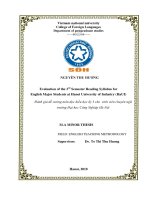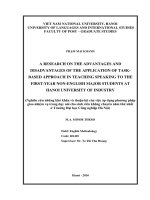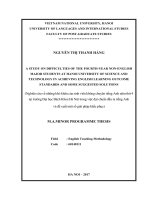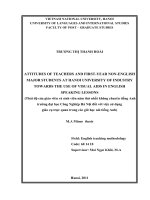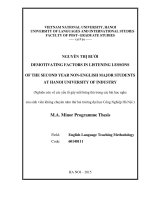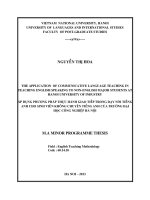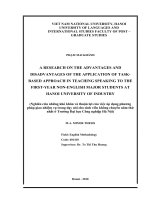The application of communicative language teaching in teaching english speaking to non english major students at hanoi university of industry
Bạn đang xem bản rút gọn của tài liệu. Xem và tải ngay bản đầy đủ của tài liệu tại đây (492.92 KB, 57 trang )
VIETNAM NATIONAL UNIVERSITY, HANOI
UNIVERSITY OF LANGUAGES AND INTERNATIONAL STUDIES
FACULTY OF POST-GRADUATE STUDIES
----------
NGUYỄN THỊ HOA
THE APPLICATION OF COMMUNICATIVE LANGUAGE TEACHING IN
TEACHING ENGLISH SPEAKING TO NON-ENGLISH MAJOR STUDENTS AT
HANOI UNIVERSITY OF INDUSTRY
ÁP DỤNG PHƯƠNG PHÁP THỰC HÀNH GIAO TIẾP TRONG DẠY NÓI TIẾNG
ANH CHO SINH VIÊN KHÔNG CHUYÊN TIẾNG ANH CỦA TRƯỜNG ĐẠI
HỌC CÔNG NGHIỆP HÀ NỘI
M.A MINOR PROGRAMME THESIS
Field : English Teaching Methodology
Code : 60.14.10
HA NOI – 2013
VIETNAM NATIONAL UNIVERSITY, HANOI
UNIVERSITY OF LANGUAGES AND INTERNATIONAL STUDIES
FACULTY OF POST-GRADUATE STUDIES
----------
NGUYỄN THỊ HOA
THE APPLICATION OF COMMUNICATIVE LANGUAGE TEACHING IN
TEACHING ENGLISH SPEAKING TO NON-ENGLISH MAJOR STUDENTS AT
HANOI UNIVERSITY OF INDUSTRY
ÁP DỤNG PHƯƠNG PHÁP THỰC HÀNH GIAO TIẾP TRONG DẠY NÓI TIẾNG
ANH CHO SINH VIÊN KHÔNG CHUYÊN TIẾNG ANH CỦA TRƯỜNG ĐẠI
HỌC CÔNG NGHIỆP HÀ NỘI
M.A MINOR PROGRAMME THESIS
Field : English Teaching Methodology
Code : 60.14.10
Supervisor: Nguyễn Huyề n Minh, M.A
HA NOI – 2013
LIST OF ABBREVIATIONS
CLT: Communicative Language Teaching
SLL: Second Language Learning
HaUI: Hanoi University of Industry
SLA: Second Language Acquisition
EFL: English as Foreign Language
iv
TABLE OF CONTENTS
PART A: INTRODUCTION……………………………………………………………1
1. JUSTIFICATION OF THE STUDY………………………………………………1
2. THE SCOPE, OBJECTIVE, RESEARCH QUESTIONS, METHOD AND
OUTLINE OF THE STUDY………………………………………………………1
2.1. The scope of the study……………………………………………………...1
2.2. Objectives of the study………………………………………………..........1
2.3. Research questions…………………………………………………………1
2.4. Method of the study………………………………………………………..2
2.5. Outline of the study………………………………………………………...2
PART B: DEVELOPMENT………………………………………………………….....4
CHAPTER I: LITERATURE REVIEW…………………………………………….....4
1. APPROACHES OF LANGUAGE TEACHING...………………………………..4
1.1. The Grammar-Translation method………………………………………....4
1.1.1. Overview………………………………………………………………..4
1.1.2. Advantages of the method………………………………………………4
1.1.3. Disadvantages of the method…………………………………………...4
1.2. The Audio-lingual method………………………………………………….5
1.2.1. Overview………………………………………………………………..5
1.2.2. Advantages of the method…………………………………………........5
1.2.3. Disadvantages of the method……………………………………….......5
2. COMMUNICATIVE LANGUAGE TEACHING…………………………….......5
2.1. Definition of CLT…………………………………………………………..5
2.2. Characteristics of CLT………………………………………………….......7
2.3. Conditions of applying CLT………………………………………………..8
2.3.1. Authentic materials…………………………………………………......8
2.3.2. Teachers ……………………………………………………………......8
2.4. Communicative competence………………………………………………..8
2.4.1. Overview………………………………………………………………..8
2.4.2. The five components of communicative competence………………….8
3. USING CLT IN TEACHING SPEAKING……………………………………....10
3.1. The nature of communication……………………………………………..10
3.2. Oral communication practice……………………………………………...10
3.3. Oral communicative activities…………………………………………….11
v
CHAPTER II: METHODOLOGY……………………………………………………14
I. BACKGROUND OF THE STUDY……………………………………………..14
1. Description of English course in HaUI…………………………………………..14
2. Description of the physical setting………………………………………………14
3. Description of objectives of the English course…………………………………15
4. Description of time allocation of the course……………………………………..15
II. SUBJECTS……………………………………………………………………….15
1. Description of teachers in HaUI………………………………………………….15
2. Description of students in HaUI………………………………………………….16
III. RESEARCH TOOLS……………………………………………………………..17
1. Class observation…………………………………………………………………17
2. Questionnaire……………………………………………………………………..18
2.1.
Questionnaire for teachers………………………………………………...18
2.2.
Questionnaires for students……………………………………………….19
3. Data analysis……………………………………………………………………...20
CHAPTER III: DATA PRESENTATION & ANALYSIS…………………………..21
I. CLASS OBSERVATION………………………………………………………..21
II. QUESTIONNAIRE………………………………………………………………23
1. Questionnaire for the teachers……………………………………………………23
2. Questionnaire for the student……………………………………………………..27
CHAPTER IV: RESULT DISCUSSION………………………………………….31
vi
I. DIFFICULTIES ………………………………………………………………….31
1. Difficulties from teachers…………………………………………………….31
2. Difficulties from students…………………………………………………….32
II. SOLUTIONS……………………………………………………………………..34
1. Solutions for teachers…………………………………………………………34
2. Solutions for students…………………………………………………………35
PART C: CONCLUSION……………………………………………………………...39
REFERENCES………………………………………………………………………….43
APPENDICES
vii
PART A: INTRODUCTION
1. Justification of the Study
Nowadays, English is widely taught in Vietnam in almost all educational institutions, at
every level. Moreover, English teaching programs are available on radio, television and
internet. English learners and teachers also raise their awareness of the importance of
English to the country’s development and integration.
However, for some time, English teaching has been strongly influenced by the traditional
methods. According to that, teachers and students used to concentrate on grammatical
items. This means that learners might be structurally competent but communicatively
incompetent. As a result, they have encountered a lot of problems with English in real life
such as: understanding and using intonation or addressing in different situations.
Therefore, speaking skills play a much more important role in modern English than ever
before. Many English teachers share the same opinion of communicative language
teaching as one of the most effective approaches in making students speak.
2. The Scope, Objectives, Research questions, Method, Outline of the Study
2.1.
The Scope of the Study
The study focuses on applying CLT in teaching speaking to non-English major students
in Hanoi University of Industry.
2.2.
Objectives of the Study
The main purpose of my study is to research on difficulties if any experienced by
teachers in teaching speaking with CLT. From that, some recommendations can be made
to deal with these difficulties.
2.3.
Research questions
The researcher needs to find answers for the two following questions:
1
-
How do the teachers of HaUI apply CLT in teaching Speaking?
-
Which difficulties do both teachers and students encounter in the process of
implementing CLT?
2.4.
Methods of the Study
Firstly, classroom observations are carried out to check whether teachers apply CLT in
teaching speaking or not. Secondly, questionnaires are given to teachers to collect more
information on difficulties that they face.
2.5.
Outline of the Study
The thesis consists of three main parts as following:
Part A is the introduction, which mentions the rationales, the focus, the objectives, the
methods and the design of the study.
Part B consists of four chapters:
Chapter I presents two main issues. The first is an overview of some methods used to
teach foreign language. The second one is about communicative language teaching in
terms of the definition, characteristics, condition in applying CLT, communicative
competence and using CLT in teaching speaking.
Chapter II mentions methodology in terms of the background, the subject and research
tools. Questionnaires are distributed to both teachers and students. Besides, the class
observation also helps to investigate applying CLT in teaching speaking to non-English
major students.
Chapter III deals with the data of the study basing on the questionnaires and the class
observation.
2
Chapter IV discusses the result drawing from the previous chapter. In this chapter, the
researcher talks about difficulty as well as solutions to overcome problem in the process
of adopting CLT in teaching speaking.
Part C is ended with a summary, which summarizes all the issues in the research.
3
PART B: DEVELOPMENT
CHAPTER I: LITERATURE REVIEW
1. APPROACHES OF LANGUAGE TEACHING
1.1.
The Grammar-Translation method
1.1.1. Overview
This method is also called “traditional method”. It was used for the purpose of helping
students read and appreciate foreign language literature. This method has some
characteristic such as:
-
Reading and writing are the major focus.
-
Vocabulary is taught through bilingual word lists, dictionary and memorization.
-
Grammar is taught deductively
-
Accuracy is emphasized.
1.1.2. Advantage of the method
This method is easy to apply because it requires few resources. It seems to be suitable for
the classes with a lot of students.
1.1.3. Disadvantage of the method
This method concerns itself primary with the written language of classical literature and
ignore authentic spoken communication and social variation of language. According to
River (1981: 31), “there is much stress on knowing rules and exceptions” and “little
stress is laid on accurate pronunciation and information; communication is neglect”.
1.2.
The Audio-lingual Method
1.2.1. Overview
4
According to Stern (1983: 463), the Audio-lingual Method was the first language
teaching method that was derived from linguistics and psychology. According to River
(1964: 19), this method has four principles:
-
Foreign language learning is a process of mechanical habit formation. Good habits
are formed by giving correct responses rather than making mistakes
-
Language skills are learned more effectively if the spoken form is learned before
the written form.
-
Analogy provides a better foundation for language learning than analysis. Drills
can enable learners to form correct analogies.
-
The meaning that the words of a language have for the native speaker can be
learned only in the context, not in isolation.
Moreover, in this method, the teacher acts as a controller selecting the language, the
students are to repeat and insisting on acute reproduction of the items.
1.2.2. Advantages of the method
This method develops students’ listening comprehension and fluency in speaking in the
target language.
1.2.3. Disadvantage of the method
When the teacher wants to apply this method, he/she must be a fluent speaker and very
resourceful to prevent students from feeling bored.
2. COMMUNICATIVE LANUAGE TEACHING
2.1.
Definition of CLT
5
It is pointed out by Brindley (1986: 11) that “the 1970’s and 1980’s could be regarded as
the era of communicative language teaching”. Nunan (1989: 194) overviews this method
as following:
CLT views language as a system for the expression of meaning. Activities involve
oral communication, carrying out meaning tasks and using language, which is
meaningful to the learners. Objectives reflect the needs of the learners; they include
functional skills as well as linguistic objectives. The learner’s role is as a negotiator
and integrator. The teacher’s role is as a facilitator of the communication process.
Materials promote communicative language use; they are task-based and authentic.
CLT is based on the theory of language as proposed by Hymes (1972) which brought
together two dependent developments: transformational generative grammar and
ethnography of communication.
CLT was expanded with the development of the notional-functional syllabus (Wilkins:
1976) and a communicative syllabus (Munby: 1978).
Canale and Swain (1980) expanded on the theoretical basis of CLT for both teaching and
testing.
According to Bock (2000), CLT is tailored to get at meaning and learners negotiate
meaning in class. Meaning is considered as what is communicated.
According to Hedge (2000), there are five components of communicative language
ability.
-
Linguistic competence: achievement of knowledge of spelling pronunciation,
vocabulary, word formation, grammatical structure, sentence structure and
linguistic semantics.
-
Pragmatic competence: According to Hedge (2000), pragmatic competence
includes illocutionary competence and socio-linguistic competence of which the
6
formers shows how to use language to gain some communicative goals or
intention, the latter involves social language to select appropriate language forms
in different contexts. Socio-linguistic competence is related to non-verbal and
verbal communication as well.
-
Discourse competence: achievement of how to understand meanings and forms in
a unified spoken or written text through cohesive devices involving forms (such
as: pronouns, conjunctions, ellipses, comparisons) and coherent devices involving
meanings (such as: repetition, progression, consistency and relevance of ideas).
This competence is called “textual competence” (Bachman, 1990).
-
Strategic competence: achievement of verbal and non-verbal strategies to find
ways to balance insufficient competence or performance limitations as well as to
promote communicative effectiveness.
-
Fluency: ability to link units of speech with facility and without strain or
inappropriate slowness, or undue hesitation.
2.2.
Characteristics of CLT
According to Li (1998: 967), CLT has six features as follows:
-
Focusing on communicative functions
-
Focusing on meaningful tasks rather than on language use
-
Trying to make tasks and language relevant to a target group of learners through
an analysis of genuine, realistic situations.
-
Using of authentic materials
-
Using of group activities
-
Attempting to create a secure and non-threatening atmosphere
7
2.3.
Conditions of applying CLT
2.3.1. Authentic materials
The teacher needs to use authentic materials suitably for the students’ different levels. For
students with the low level of proficiency in the target language, he/she can use weather
forecast and ask them to predict. For those with higher level, the authentic material can
be newspaper articles, books, live radio and television broadcasts.
2.3.2. Teachers
Teachers play the most important role in applying CLT. They are both facilitators of
students’ learning and managers of classroom activities. When students take part in
activities, teachers act as advisors and monitors and sometimes as co-communicator to
involve in communicative activities with students.
2.4.
Communicative Competence
2.4.1. Overview
Communicative competence is recognized as primary goal of language teaching. It is
composed of both grammatical
competence
and socio-linguistic competence.
Communicative language teaching tries to facilitate the integration of these two equally
important components for the learners and helps them to acquire communicative
competence.
2.4.2. The five components of communicative competence
2.4.2.1.
Rules of grammar
According to Savignon (1983), “Grammatical competence is the mastery of the linguistic
code, the ability to recognize the lexical, morphological, syntactic and phonological
features of a language and to manipulate these features to forms words and sentences.
Grammatical competence does not link to any single theory of grammar, nor does it
8
assume the ability to make explicit the rule of usage. A person demonstrates grammatical
competence by using a rule, not by stating a rule.”
2.4.2.2.
Sociocultural rules of use
It requires an understanding of the social context in which language is used: the role of
the participants, the information they share, the functions of the interaction, the degree of
formality, setting, topic, channel and purposes of communication so that judgments can
be made on the appropriateness of a particular utterance.
2.4.2.3.
Rules of discourse
Competence in rules of discourse is the ability to understand a group of utterances as a
whole depending on the cohesive relationship marked by cohesive devices such as
pronouns, conjunctions, synonyms, ellipses, comparisons, parallel structures which relate
what is about to be said to what has already been said. It is also the ability to understand
the logical relationship between utterances depending on one’s general knowledge of the
world.
2.4.2.4.
Probability rules of occurrence
The competence of probability rules of occurrence is the ability to understand what
communicative functions are likely to be expressed in a given context and what not. This
competence may be acquired more through using the language in real life communication
than in classroom practice.
2.4.2.5.
Communication strategies
They are used to compensate for imperfect knowledge of rules, or limiting factors in their
application such as fatigue, distraction, inattention. They are also included the ability to
adapt when one’s message is not taken, and to sustain communication by paraphrase,
circum-locution, repetition, hesitation, avoidance, guessing and shift in register and style.
9
Communication strategies are important for communicative competence in all contexts
and considered being an essential component in a descriptive framework for
communicative competence.
3. Applying CLT in Teaching Speaking
3.1.
The nature of communication
Communication is a complex and changing phenomenon. We can summarize the
generalizations about the nature of communication in the following figure:
Speaker/hearer
Wants to say something
Has a communicative purpose
Selects from language store
Listener/reader
Wants to listen to something
Interested in communicative purpose
Processes a variety of language
3.2.
Oral communication practice
Pattison (1987: 7) finds the characteristics of typical oral practice between teachers and
learners in the classroom, and the way foreign and native speakers communicate with
each other outside classroom. They are listed below:
List 1
FL (oral)
Practice in the classroom
List 2
FL (oral)
Communication outside the classroom
WHAT: content of communication
Content or topic is decided by teacher, Speakers express freely. They are fully
textbook, tape, etc. the content is highly aware of the meaning conveyed. The exact
predictable.
content is unpredictable.
WHY 1: reason for communication
Students speak to practice speaking; Students have a reason to speak, to fill an
because teacher tells them to; to get to information gap, etc. or the information is
10
good mark, etc.
interesting or useful for the participants.
WHY 2: Result of communication
The “extrinsic motivation” is achieved as The “intrinsic motivation” is satisfied when
the FL is practiced; the teacher accepts or the aims are reached, information gap is
corrects what is said and good mark is filled, a problem is solved, or a social
given.
contact is made, etc.
WHO: participants in communication
Not everyone pays attention to what is Two or more people usually face each
expressed except for the teacher, who pays other, paying attention and responding to
less attention to what they say than to how what is said, rather than how correctly it is
well they say it.
said.
HOW: means of communication
Language is closely adapted to learners’ Native speaker output is adjusted to
level. All speech is as accurate as possible foreigners’ level. Meaning is conveyed by
and completed sentences. Problems in any means at the speakers’ command.
communicating meaning are solved by Problems are dealt with by negotiation and
translation. Learners are controlled to use exchange of feedback between speakers.
standard forms
Errors not affecting communication are
largely ignored.
3.3.
Oral communicative activities
There are many speaking activities for use in the classroom as followings:
3.3.1. Role-play
This activity is very important in CLT because it gives students opportunities to
communicate in different social contexts and in different social roles. The students in the
class are divided into pairs or groups and given contexts and roles to act out. The roles
can be shopkeeper, policeman, interviewer, etc who can be in different moods such as:
bold or frightened, irritated or amused, etc. Situations are usually true to life, so the
11
speech is close to authentic discourse. Students also receive feedback on whether or not
they have effectively communicated.
3.3.2. Problems-solving tasks
Problem solving tasks work well in CLT because they usually include the three features
of communication: information gap, choice and feedback. They can be structured so that
students share information or work together to arrive at a solution. In this activity, the
class is divided into groups of about four students and is given “problem”. Each group
negotiates with each other and then selects a representative to report in front of the class
after working out solution to that problem.
3.3.3. Discussion
Discussion is also very effective in CLT because it gives students a practice in
negotiating meaning and chances to express themselves in the target language. Groups of
four or ten students are working on a topic of common interest for about ten or more
minutes and then a representative is chosen to report what they have discussed.
3.3.4. Cued story
Cued story is used effectively with the beginner because it helps them improve their
speaking skills and be familiar with speaking in front of the crowd. Students work
individually, imagine or devise a complete story based on the given cues. Then they are
invited to speak from their memory with some help from the paper sheet.
3.3.5. Picture story
This is like cued story but students learn to work and negotiate meaning with their partner
or people in group to act on the tasks. Students work in pairs or in groups, making up a
story from a set of pictures. Then one of them in the group is summoned up to the front to
tell the story.
4. Previous study
12
Li (1998) investigates the difficulties experienced by 18 South Korean secondary school
teachers of English when CLT is applied in teaching English to secondary pupils in South
Korea. He carries out his research by delivering the formal questionnaires as well as
interviewing all of these teachers to find out the difficulties in implementing CLT in
teaching English. The hindrances in the result of his survey fall into four categories: by
the teachers, by the students, by the educational system and by CLT itself. The troubles
that the teachers have to encounter are categorized into 6 major constraints such as:
deficiency in spoken English deficiency in strategic and socio-linguistic competence;
lack of training in CLT; few opportunities for retaining in CLT; misconceptions about
CLT; little time and expertise for developing communicative materials. The difficulties
caused by the students are low English proficiency, lack of motivation for communicative
competence and resistance to participating in class. The others caused by the educational
system are classified into 4 major kinds as large classes, grammar-based examinations,
lack of money funding, and lack of support. The rest of problems caused by CLT ifself
are identified as CLT’s inadequate account of EFL teaching; the lack of effective and
efficient assessment instrument in CLT.
13
CHAPTER II: METHODOLOGY
I.
Background of the study
1. Description of English course in HaUI
The English course in HaUI is divided into two stages:
The first stage is the stage for general English which lasts 450 periods, from the first
semester to the fifth semester. Depending on the characteristics of each major, different
textbooks are used. Normally, New Headway the 3rd edition is used for the most majors
in HaUI. The textbook develops students’ four skills and have the following features:
-
The textbook helps students learn the real things from newspapers, magazines and
daily conversations.
-
The book develops students’ communicative competence. They are required to
work in pairs, in groups, to practice English in common situations. Furthermore,
students have chances to listen both to native and non-native English speakers
from the tapes or CDs used with the books.
-
The book focuses on communicative competence without ignoring linguistic
competence, so in the book the students are required to master the grammatical
structures such as: tenses, comparison, passive voice, conditional sentences, etc.
The second stage is the stage for specific purpose which lasts 45 periods in the last
semester. The course book for this stage is designed by teachers in the English
department.
2. Description of the physical setting
-
The class size: each class has about 25-30 students
-
English department has an overhead projector, a cassette player, CD, a television.
-
There is a library in HaUI but there are not many English books for reference and
self-study.
14
-
All of the classrooms are designed for lecture lessons. It means that the seating is
arranged orderly in front of the teacher and classroom equipment is just a
blackboard.
3. Description of objectives of the English course
The requirements of students at the end of semester are stated in the syllabus as follows:
-
To have general knowledge of English grammar and an active vocabulary of about
2000 words.
-
The ability to communicate with foreigners in the target language in some
situations such as: showing ways, asking to check foreigner’s suspecting luggage,
contacting with someone for special mission, etc
-
The ability to understand the professional terms used in their job.
4. Description of time allocation of the course
There are 6 periods a week for all four skills whereas a higher proportion of contact hours
are needed to develop the speaking skill.
II. The subjects
1. Description of teachers in HaUI
In HaUI, the English department consists of three groups:
-
English major group
-
The first non-English major group: in charge of pupils at vocational level
-
The second non-English major group: in charge of students at university and
college level
Teachers the researcher mentions here come from the 2nd non-English major group. There
are 80 teachers in this group and none of them have ever been to English speaking
15
countries. There are 20 male and 60 female teachers ranged from 23 to 38 years in age.
Their experience in teaching English varies from 3 to 16 years.
The following table shows that the staff members in the 2nd non-English major group of
the English Department in HaUI are very young.
Table 1: Description of teachers’ working experience
Years of teaching
Age
Numbers of staff
3-5
25-27
40
6-9
28-31
15
12-14
34-36
5
>15
>37
15
2. Description of students in HaUI
They all have passed a rather challenging University Entrance Examination with other
subjects except for English. They are both male and female from different parts of the
country such as: big cities, provinces and mountainous areas.
The percentage in table 2 shows the background of English of the students
Table 2: Students’ background of English
Items
Students have learnt English for 7 years
16
Numbers
Percentage
350
58.3%
Students have learnt English for 3 years
225
37.5%
Students have never learnt English
25
4.2%
Never speak English to the foreigners
500
83.3%
Sometimes speak English to the foreigners
90
15%
Always speak English to the foreigners
10
E1.7%
Students attend English classes in foreign language centers
150
25%
Students participate in English speaking clubs
200
33.3%
There are 39 English classes (only first year), belonging to 10 non-English major
faculties in HaUI at the time of class observation and delivering questionnaire. To have
reliable statistics, more than half of the classes should be included in the survey. To be
objective, judgmental sampling is not possible because these classes are not at the same
level. So the classes must be picked by random sampling. Therefore, the researcher writes
on 20 pieces of paper 20 numbers ranged from 20 to 39 (to be sure that the number
chosen is more than half of the classes) and randomly selects one of them. The number
chosen is 25. Therefore, twenty-five classes are selected.
Only first year classes are chosen because there are so many classes at that time.
Moreover, students of the other 8 faculties passed University Entrance Examination with
English as a compulsory subject. Therefore, their textbook is International Express
instead of New Headway. After the English course, they will get Toefl certification.
II.
Research Tools
Two measurement instruments were developed for data collection. They are consists of:
1. Class observation
17
The class observation was carried out by visiting 25 classes and recording all activities
occurred in each class. Basing on the information about CLT and the conditions of
applying CLT mentioned in the previous parts, the researcher conducted the class
observation with four following criteria:
-
Teacher’s role
-
Student’s role
-
Methodology
-
Classroom activities
To design the class observation with these above criteria, the researcher adapted from the
ideas of Jack C. Richard in the book named “Communicative Language Teaching Today”
(2006). Moreover, in the researcher’s opinion, these above criteria are the typical
characteristics of a CLT speaking class.
The assessment is divided into two scales: applicable (using CLT) and not applicable (not
using CLT)
2. Questionnaire
The two questionnaires were designed by basing on the results of the class observation.
They include both closed and open-ended questions
2.1.
Questionnaires for teachers
The questionnaire designed for the teachers aimed at seeking information about the
teachers’ working experience, teachers’ perceptions of CLT, problems they confronted
with in the process of teaching, and way to exploit available teaching aids in teaching
English. There are ten questions:
-
Question 1 requests the matter concerning the teacher’s working experience
18
-
Question 2 is about the teachers’ perception of CLT through the workshops on
language teaching.
-
Question 3, 9 relate to the teachers’ opinion about the implementing of CLT
-
Question 4, 5, 6, 7 aim at finding out the problems that teachers confront with in
the process of teaching.
-
Question 8, 10 ask teachers’ solutions for the difficult situations they met.
2.2.
Questionnaires for students
To make sure that the questionnaire has adequate reliability, the second questionnaire is
distributed to 750 students. This questionnaire consists of 10 questions:
-
Question 1 relates to the English background of the learners before entering Hanoi
University of Industry.
-
Question 2, 3, 4 relate to extra-curriculum activities such as English speaking
clubs, English evening courses which students have been attending, the
opportunities of using English out of the classroom.
-
Question 5, 6 focus on the students’ needs and wants when attending the English
course in the curriculum.
-
Question 7, 8 are concerning about the difficulties that the students probably face
with while learning English.
-
Question 9 aims at detecting the students’ opinion about the time allotted for
teaching and learning English in the curriculum.
-
Question 10 help to find out the students’ needs in learning English and their
suggestions
19
